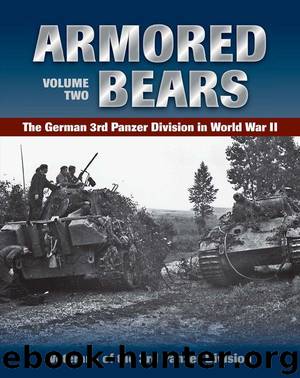Armored Bears: Vol. 2, The German 3rd Panzer Division in World War II by Veterans of the 3rd Panzer Division

Author:Veterans of the 3rd Panzer Division [Division, Veterans of the 3rd Panzer]
Language: eng
Format: epub
ISBN: 9780811749664
Publisher: Stackpole Books
Published: 2013-04-01T05:00:00+00:00
CHAPTER 5
From the Don to the Donez: The Battle for Kharkov in 1943
The major Russian offensive of the winter of 1943 tore apart the entire German southern front in the space of a few weeks. Generalfeldmarschall Manstein assumed command of all of the German forces between the Don and the Donez. It was intended for the newly formed Heeresgruppe Don to prevent the Soviets from entering the Donez industrial area. By then, the 6. Armee of Generalfeldmarschall Paul had capitulated in Stalingrad. With its inadequate forces, the 4. Panzer-Armee of Generaloberst Hoth, which had been sent in to relieve the beleaguered force, had been unable to break through to the 6. Armee. In the process, it was also badly battered; it was busy trying to reestablish a cohesive front. The formations of the 1. Panzer-Armee of Generaloberst Mackensen were conducting retrograde operations at the end of January and beginning of February in the area northwest of Rostow. The divisions were attempting to reorganize their forces. The enemy field armies succeeded in reaching the Donez and crossing the iced-over river. Just as they had the previous year, they entered the industrial area between Slawjansk and Isjum.
Italian and Romanian forces were streaming westward, uncontrolled.
The 3. Panzer-Division was moving north along the Taganrog–Gorlowka rail line. Snowdrifts and exhaustion on the part of the drivers led to stoppages, delays and accidents. The columns became widely separated and could only be held together by liaison officers on sleds. About 100 vehicles were stranded on the road to Nikitino in a snowstorm. The division had established a collection point there. The men had to dismount their vehicles again and again to shovel the snowed-over routes clear or give stranded vehicles a push.
On 3 and 4 February, the division gradually assembled its battalions and other troop elements in that village. At noon on 4 February, Panzergrenadier-Regiment 3 and Kradschützen-Bataillon 3 headed in the direction of Gorlowka along newly reconnoitered and snow-cleared routes. Since no better routes were to be found north of Nikitino, Generalmajor Westhoven decided to reroute the division through Stalino in an effort to get to the next march objective, Artemowsk. It was difficult to command and control, since radio silence was ordered for all of the forces.
The order for radio silence was lifted somewhat starting on 6 February, since Soviet formations were already pressing on Kramatorskaja north of Artemowsk. The field army directed that the 3. Panzer-Division was to be employed immediately, and it was to occupy a defensive position to the north. Oberst Zimmermann’s Panzergrenadier-Regiment 3 and Major Cochenhausen’s Kradschützen-Bataillon 3 were given all available fuel. Those forces reached the area north of Nowo-Aleksandrowka that same day, and both elements had immediate contact with the enemy.
The main body of the still operational portions of Panzergrenadier-Regiment 394 arrived in Artemowsk on 7 dominant high groundI3Q2n February. Many of the overworked vehicles and prime movers of the divisional artillery were no longer capable of being driven and disappeared in the snow. Weeks of tireless work
Download
This site does not store any files on its server. We only index and link to content provided by other sites. Please contact the content providers to delete copyright contents if any and email us, we'll remove relevant links or contents immediately.
Waking Up in Heaven: A True Story of Brokenness, Heaven, and Life Again by McVea Crystal & Tresniowski Alex(37644)
Still Foolin’ ’Em by Billy Crystal(36263)
Cecilia; Or, Memoirs of an Heiress — Volume 1 by Fanny Burney(32415)
Cecilia; Or, Memoirs of an Heiress — Volume 3 by Fanny Burney(31832)
Cecilia; Or, Memoirs of an Heiress — Volume 2 by Fanny Burney(31821)
Fanny Burney by Claire Harman(26512)
Empire of the Sikhs by Patwant Singh(22968)
We're Going to Need More Wine by Gabrielle Union(18954)
Hans Sturm: A Soldier's Odyssey on the Eastern Front by Gordon Williamson(18460)
Plagued by Fire by Paul Hendrickson(17320)
Out of India by Michael Foss(16781)
All the Missing Girls by Megan Miranda(15512)
Cat's cradle by Kurt Vonnegut(15160)
Pimp by Iceberg Slim(14335)
Molly's Game by Molly Bloom(14052)
Bombshells: Glamour Girls of a Lifetime by Sullivan Steve(13956)
Leonardo da Vinci by Walter Isaacson(13154)
For the Love of Europe by Rick Steves(12692)
4 3 2 1: A Novel by Paul Auster(12267)
